Yellowstone National Park is a vast and stunning destination with a variety of natural wonders to explore. Here are some notable places to visit within Yellowstone
1. Mammoth Hot Springs Terraces

“Mammoth Hot Springs Terraces abut against the rugged landscape of Yellowstone National Park. These unique geological formations showcase a stunning display of travertine terraces, shaped by the constant flow of hot, mineral-rich water from the park’s extensive hydrothermal system. As visitors explore the area, they are treated to a mesmerizing palette of colors created by thermophiles – heat-loving microorganisms – thriving in the vibrant environment. The terraces, with their intricate patterns and vibrant hues, stand as a testament to the dynamic forces at work beneath the Earth’s surface in this geothermal wonderland.”
2. Lamar Valley Wildlife Watching

Lamar Valley is renowned for its exceptional wildlife watching opportunities within Yellowstone National Park. Nestled amidst picturesque landscapes, this valley is a prime location for observing a diverse range of wildlife in their natural habitat. Visitors can witness the majestic presence of bison grazing on the expansive grasslands, elk moving through the meadows, and herds of pronghorn antelope navigating the terrain.
Moreover, Lamar Valley is celebrated for its thriving wolf population, making it one of the best places in the park to catch a glimpse of these elusive predators. The valley’s open vistas offer an ideal setting for spotting other wildlife as well, including bears, coyotes, and a variety of bird species.
Whether by car or on foot, wildlife enthusiasts are treated to a captivating experience as they immerse themselves in the natural beauty of Lamar Valley, capturing glimpses of the park’s diverse fauna against the backdrop of stunning landscapes.
As the sun begins to set over Lamar Valley, the chances of encountering wildlife increase, adding an extra layer of magic to the experience. The golden hues of the fading daylight create a captivating atmosphere, and the valley comes alive with the sounds of nature.
Photographers and nature enthusiasts often find Lamar Valley to be a haven for capturing memorable moments. The juxtaposition of the wildlife against the breathtaking scenery provides endless opportunities for stunning photographs. The park’s commitment to conservation has allowed these creatures to thrive, and Lamar Valley stands as a testament to the delicate balance of ecosystems within Yellowstone.
For those seeking a more immersive experience, ranger-led programs and guided tours are available, providing valuable insights into the behaviors and ecological significance of the diverse species inhabiting the valley. Whether you’re an avid wildlife enthusiast or a casual observer, Lamar Valley offers a unique and unforgettable window into the wonders of the natural world in Yellowstone National Park.
3. Fairy Falls Hike
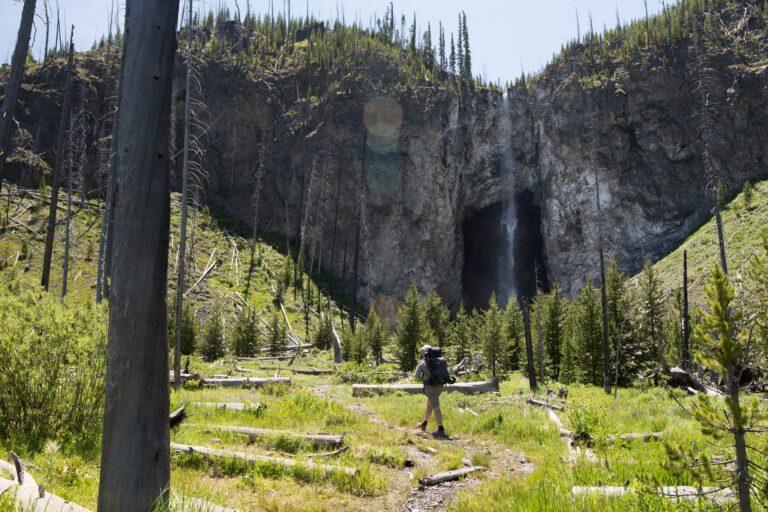
Embarking on the Fairy Falls Hike is a delightful journey into the scenic wonders of Yellowstone National Park. This moderately easy trail takes hikers through lush landscapes, showcasing the park’s diverse flora and fauna. The trailhead, conveniently located near the Midway Geyser Basin, serves as a gateway to this enchanting adventure.
The hike to Fairy Falls covers approximately two miles (3.2 km) each way, providing a leisurely yet rewarding experience for nature enthusiasts. Along the way, hikers are treated to panoramic views of the surrounding mountains and meadows, creating a picturesque backdrop for the journey.
The highlight of the hike is, of course, Fairy Falls itself. Cascading gracefully from a height of approximately 200 feet (61 meters), the waterfall captivates with its ethereal beauty. The fine mist generated by the falls creates rainbows on sunny days, adding a magical touch to the overall experience.
Fairy Falls is not only a visual spectacle but also a tranquil spot to relax and appreciate the serenity of nature. Many hikers choose to linger, enjoying a picnic amidst the natural beauty before retracing their steps back to the trailhead.
This hike is particularly popular during the warmer months when the park’s flora is in full bloom, and the vibrant colors of wildflowers add to the allure of the surroundings. Whether you’re a seasoned hiker or someone looking for a refreshing and accessible outdoor experience, the Fairy Falls Hike is a gem within the treasures of Yellowstone National Park.
As you continue along the trail, the sounds of rustling leaves and the occasional bird song provide a peaceful soundtrack to your hike. The path meanders through a mixed forest, offering glimpses of the diverse wildlife that call Yellowstone home. Keep an eye out for squirrels, chipmunks, and perhaps even larger mammals like elk or deer.
The terrain remains relatively flat, making it an ideal hike for families or those seeking a more relaxed outdoor experience. Interpretive signs along the way provide information about the park’s geology, flora, and fauna, adding an educational element to your journey.
Upon reaching Fairy Falls, the sight of the waterfall is a breathtaking reward for your efforts. The vantage point near the base allows for a closer look at the cascading water and the moss-covered rocks surrounding it. Many hikers find this spot to be not only a great photo opportunity but also a peaceful retreat to absorb the natural beauty.
For those with extra energy and time, the trail continues to the Grand Prismatic Spring Overlook. This extension provides a bird’s-eye view of the vibrant colors of the Grand Prismatic Spring, one of Yellowstone’s most iconic thermal features.
As you conclude your Fairy Falls Hike and head back to the trailhead, the memories of the serene landscapes and the majestic waterfall will linger, leaving you with a deep appreciation for the natural wonders that abound in Yellowstone National Park.
4. Norris Geyser Basin's Back Basin
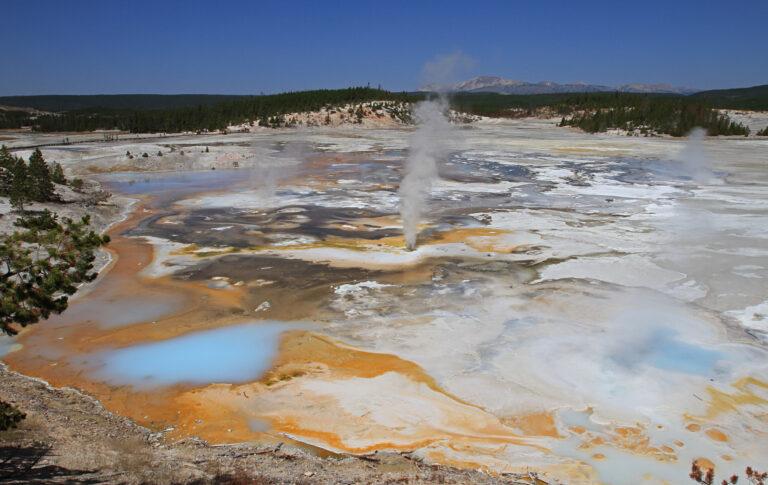
Exploring the Norris Geyser Basin’s Back Basin is a captivating journey into the heart of Yellowstone National Park’s geothermal wonders. Nestled within the larger Norris Geyser Basin, the Back Basin offers visitors a unique and otherworldly landscape shaped by the park’s active hydrothermal features.
The Back Basin trail, known for its boardwalks that traverse the dynamic terrain, allows hikers to witness a mesmerizing array of geysers, hot springs, and bubbling pools. As you venture into this geothermal wonderland, the distinct smell of sulfur and the sight of rising steam set the stage for an unforgettable experience.
One of the highlights of the Back Basin is Steamboat Geyser, the world’s tallest currently active geyser. While eruptions are unpredictable, witnessing Steamboat Geyser unleash powerful jets of water and steam into the air is a rare and awe-inspiring spectacle. The trail also leads to other notable features such as Emerald Spring, Pearl Geyser, and Vixen Geyser, each with its own unique characteristics and colors.
The vibrant microbial mats surrounding the thermal features create a striking contrast against the barren, alien-like landscape, showcasing the resilience of life in extreme conditions. Interpretive signs along the boardwalk provide insights into the geology, ecology, and the delicate balance of this geothermal ecosystem.
Exploring the Norris Geyser Basin’s Back Basin is a journey into the raw forces that shape Yellowstone’s landscape. It’s a reminder of the Earth’s dynamic nature and the delicate harmony between geothermal activity and the park’s natural beauty. As you complete the trail, the memories of the bubbling, steaming landscape and the unique geothermal features will stay with you, offering a glimpse into the geological wonders that make Yellowstone a truly extraordinary destination.
As you continue your exploration of the Back Basin, the dynamic and ever-changing nature of the geothermal features becomes increasingly apparent. The landscape is a canvas of colors, with vibrant hues caused by thermophiles—microorganisms that thrive in the extreme temperatures of the thermal features. The intricate patterns created by these microscopic life forms add to the surreal beauty of the area.
The trail meanders through a geologically active zone, where you may encounter the unexpected eruption of smaller geysers or witness the constant bubbling of hot springs. The sounds of boiling water and hissing steam create an atmospheric soundtrack, underscoring the geological forces at play beneath the Earth’s surface.
As you approach features like Porkchop Geyser and Pinwheel Geyser, the variety in shapes and behaviors of the geothermal features becomes apparent. Some gently release steam, while others sporadically shoot water into the air, providing a captivating display of the park’s natural geothermal activity.
Throughout the Back Basin, the boardwalks ensure both safety and preservation of the delicate thermal formations. It’s a reminder of the importance of responsible exploration to protect both visitors and the unique ecosystem of Norris Geyser Basin.
Completing the trail, you’ll leave with a profound appreciation for the geothermal wonders of Yellowstone. The Back Basin stands as a testament to the powerful geological forces that shape the park, offering visitors a glimpse into the Earth’s inner workings and the remarkable beauty that arises from its dynamic and ever-changing nature.
5. Bechler Falls

Bechler Falls is a hidden gem nestled within the serene wilderness of Yellowstone National Park. Tucked away in the remote southwestern corner of the park, this waterfall offers visitors a tranquil and picturesque retreat. The journey to Bechler Falls is an adventure through lush forests, meandering rivers, and the unspoiled beauty of Yellowstone’s backcountry.
The trailhead to Bechler Falls often begins at the Bechler Ranger Station, and from there, hikers can embark on a moderately challenging trek that winds through the enchanting Bechler Meadows. The landscape is dotted with wildflowers during the warmer months, creating a colorful tapestry against the backdrop of towering trees.
As you follow the trail, the sound of rushing water becomes a constant companion, signaling the approach to Bechler Falls. The waterfall, with its cascading tiers, plunges into a crystal-clear pool below, creating a mesmerizing display of nature’s artistry. The secluded setting adds to the sense of discovery, making the visit to Bechler Falls a peaceful and contemplative experience.
Wildlife sightings are common along the trail, offering opportunities to observe the park’s diverse fauna. Moose, elk, and a variety of bird species are among the inhabitants of this remote and pristine wilderness.
Bechler Falls is particularly captivating during the autumn months when the surrounding foliage transforms into a palette of rich, warm colors. The fall colors, combined with the soothing sounds of the waterfall, create a sensory symphony that enhances the overall beauty of the area.
As you leave Bechler Falls and make your way back through the untamed landscapes of Yellowstone’s southwest, the memories of this hidden waterfall linger as a testament to the park’s vast and undiscovered wonders. The journey to Bechler Falls is not just a hike; it’s a voyage into the untouched and sublime corners of Yellowstone’s wilderness.
As you continue your exploration beyond Bechler Falls, the trail offers additional natural wonders that showcase the diversity of the Yellowstone backcountry. The Bechler region is renowned for its thermal features, and hikers may encounter geysers, hot springs, and fumaroles along the way. These geothermal features contribute to the unique character of the landscape, with steam rising amidst the pristine wilderness.
The trail system in the Bechler area also provides opportunities for those seeking a multi-day backpacking adventure. Hikers can venture deeper into the backcountry, discovering more waterfalls, including the awe-inspiring Iris Falls, and immersing themselves in the solitude of this remote corner of the park.
The Bechler region is intersected by the meandering Bechler River, offering scenic spots for a peaceful rest or a refreshing break. The soothing sounds of the river create a harmonious backdrop to your journey, further enhancing the sense of tranquility that permeates this less-explored part of Yellowstone.
Wildlife enthusiasts will appreciate the diverse ecosystems surrounding the Bechler area. Keep a watchful eye for sightings of otters, beavers, and an array of birdlife. The park’s commitment to preserving natural habitats ensures that the Bechler region remains a sanctuary for both wildlife and those seeking a genuine wilderness experience.
Whether you choose a day hike to Bechler Falls or embark on a more extended backpacking trip, the journey through this hidden corner of Yellowstone leaves an indelible mark. It becomes a personal exploration of nature’s wonders, offering solitude, discovery, and a profound connection with the untamed beauty that defines the essence of Yellowstone National Park.
6.Black Sand Basin
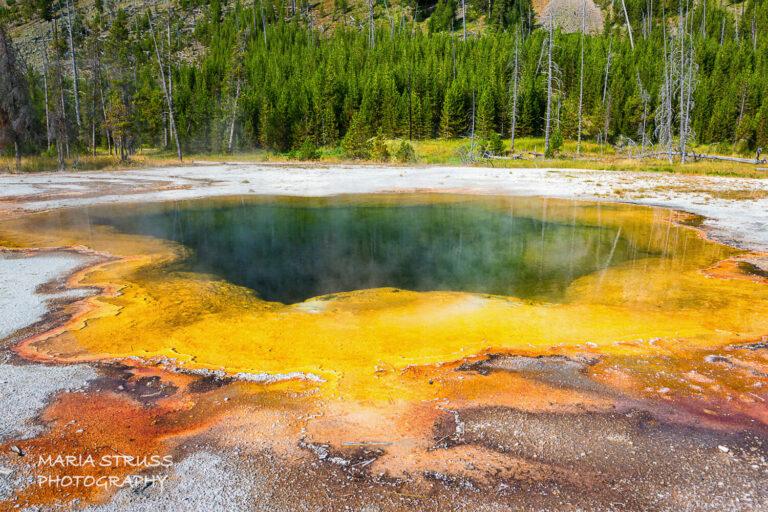
Nestled within the vibrant geothermal landscape of Yellowstone National Park, Black Sand Basin stands as a captivating testament to the park’s geological wonders. Located near the Old Faithful area, this lesser-known gem offers visitors a unique and colorful display of hot springs, geysers, and other thermal features.
As you explore Black Sand Basin, the first striking feature you encounter is the deep azure pool of Opal Pool. The vivid blue water is surrounded by an intricate crust of silica, creating a visually stunning contrast. Nearby, the Jewel Geyser adds to the spectacle with its frequent eruptions, sending bursts of water into the air against the backdrop of the surrounding thermal features.
Walking along the boardwalks that wind through the basin, you’ll discover Rainbow Pool, a hot spring with hues ranging from deep blue to red and yellow. The chromatic variations are a result of the thermophiles thriving in the different temperature zones of the pool.
The centerpiece of Black Sand Basin is undoubtedly the Emerald Pool, a brilliantly colored hot spring with vibrant green and blue hues. The unique microbial mats create an artistic pattern around the pool, enhancing its otherworldly beauty. Visitors often find themselves captivated by the mesmerizing colors and the steam rising from the thermal features.
As you continue your journey through the basin, the Cliff Geyser and Sunset Lake add their own charm to the landscape. The black sand that gives the basin its name forms a stark contrast against the vibrant colors of the thermal features, creating a surreal and captivating scene.
Black Sand Basin provides a more intimate and serene experience compared to some of the larger geyser basins in Yellowstone. The accessibility of the boardwalks ensures a safe exploration of the geothermal features while allowing visitors to marvel at the beauty and power of Yellowstone’s hydrothermal activity.
In the quiet corners of Black Sand Basin, surrounded by bubbling pools and hissing steam, you’ll find a unique harmony between the forces of nature and the serenity of this remarkable thermal area. The basin’s geological marvels and vivid colors contribute to the rich tapestry of Yellowstone’s unparalleled natural wonders.
As you stroll further through Black Sand Basin, the scenery unfolds with the striking Cliff Geyser, which intermittently erupts, sending plumes of water and steam into the air. The rhythmic dance of the geysers and the ever-present hiss of escaping steam add an audible dimension to the visual spectacle.
A short walk from Cliff Geyser leads to the Spouter Geyser, a feature that lives up to its name by continuously spouting water and steam. This dynamic display exemplifies the constant geothermal activity beneath the Earth’s surface.
The basin’s enchanting surroundings make it an ideal spot for contemplation and photography. The ethereal beauty of the landscape, combined with the unique microbial life flourishing in the thermal features, creates a captivating atmosphere. It’s a testament to the resilience of life in extreme conditions, showcasing the adaptability of microorganisms to the scalding temperatures of the geothermal pools.
The journey through Black Sand Basin is a sensory experience, with the aroma of sulfur lingering in the air and the vivid colors of the thermal features reflecting the geological diversity of Yellowstone. Visitors often find themselves immersed in the moment, surrounded by the primeval forces that have shaped the park’s landscape over millions of years.
As you conclude your exploration of Black Sand Basin, the memories of its vivid colors, erupting geysers, and the intricate beauty of the thermal features will linger. It’s a snapshot of the remarkable geothermal wonders that make Yellowstone National Park a globally recognized treasure, and Black Sand Basin stands as a hidden jewel within this expansive natural tapestry.
7.Tower Fall Trail
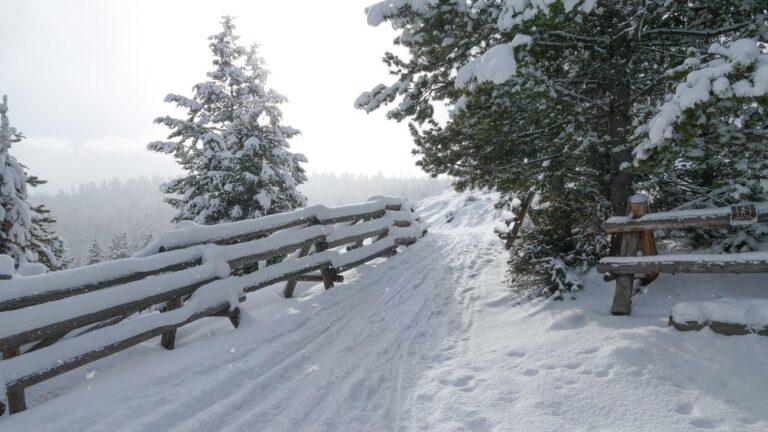
The Tower Fall Trail invites hikers into the northeastern reaches of Yellowstone National Park, offering a captivating journey through diverse landscapes and culminating in the stunning spectacle of Tower Fall. This moderately challenging trail provides a memorable adventure, combining scenic beauty with the powerful force of nature.
Beginning near the Roosevelt Lodge, the trail winds its way through wooded areas, exposing hikers to the sights and sounds of the park’s diverse flora and fauna. Wildlife sightings, including bison and elk, are not uncommon along the trail, providing an added element of excitement.
As the path continues, the murmurs of Tower Creek accompany hikers, gradually building anticipation for the main attraction. The trail’s elevation changes are moderate, making it accessible to a range of hikers, from casual walkers to those seeking a more invigorating trek.
Approaching Tower Fall, the scenery transforms into a breathtaking display of natural beauty. Tower Fall, with its 132-foot (40-meter) drop, cascades over a columnar basalt rock formation, creating a dramatic and picturesque scene. The canyon walls frame the waterfall, enhancing its grandeur, and a viewpoint near the falls allows visitors to absorb the sheer power and beauty of this iconic Yellowstone landmark.
During the warmer months, wildflowers adorn the surrounding meadows, adding vibrant colors to the landscape. The juxtaposition of the lush vegetation against the rugged canyon walls and the thundering waterfall makes Tower Fall a compelling subject for nature enthusiasts and photographers alike.
For those seeking a longer adventure, the trail connects to the Specimen Ridge Trail, leading to additional geological wonders and panoramic vistas. Whether enjoyed as a standalone hike or as part of a more extensive exploration, the Tower Fall Trail stands as a testament to the rich diversity and natural splendor that define Yellowstone National Park.
As you venture beyond Tower Fall, the trail continues to unveil the unique features of the Yellowstone landscape. The Specimen Ridge Trail, which can be accessed from the Tower Fall Trail, takes hikers on a more extensive exploration of the park’s geological wonders.
Specimen Ridge is renowned for its petrified forests, where ancient trees have transformed into colorful agate and opalized specimens. This geological phenomenon offers a fascinating glimpse into the park’s prehistoric past and the dynamic processes that have shaped its terrain over millions of years.
The trail meanders through meadows and forests, providing opportunities for wildlife sightings and serene moments of reflection. Elk and bison are often spotted in these areas, grazing peacefully against the backdrop of the park’s diverse ecosystems.
As you ascend Specimen Ridge, panoramic views of the Yellowstone Caldera unfold, offering a perspective on the vastness of the park and the forces that have shaped its expansive landscapes. The trail invites hikers to immerse themselves in the wilderness, where the quietude is interrupted only by the sounds of nature—the rustling of leaves, the calls of birds, and the distant rush of water.
For those seeking a challenging and rewarding trek, continuing onto Specimen Ridge adds depth to the Tower Fall Trail experience. The synthesis of geological wonders, wildlife encounters, and the sheer beauty of the natural surroundings makes this journey a memorable exploration of Yellowstone’s northeastern reaches.
Whether you choose to revel in the grandeur of Tower Fall or extend your adventure along Specimen Ridge, the trails in this area exemplify the richness of Yellowstone’s ecosystems and the harmonious blend of geology, flora, and fauna that define this iconic national park.
8.Shoshone Lake Kayaking
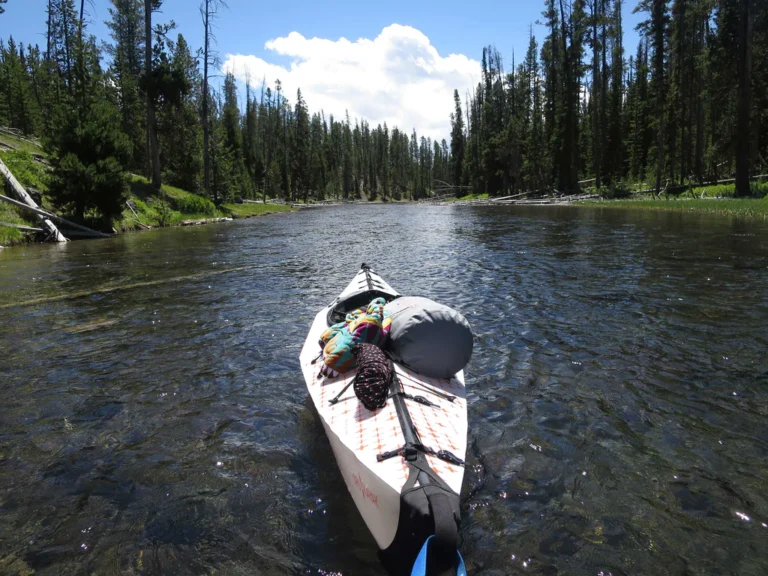
Shoshone Lake, situated in the remote backcountry of Yellowstone National Park, offers a pristine and tranquil setting for kayaking enthusiasts. This expansive lake, nestled amidst the picturesque Absaroka mountain range, provides a unique opportunity to explore the park’s natural beauty from a different perspective.
Embarking on a kayaking adventure on Shoshone Lake begins with a sense of serenity as you paddle across the clear waters surrounded by dense forests and undisturbed wilderness. The lake, fed by pristine mountain streams, is one of the largest backcountry lakes in the United States, providing ample space for paddlers to explore and appreciate the unspoiled environment.
Paddling along the shoreline, you may encounter a variety of wildlife, including waterfowl, beavers, and possibly even moose or bears along the water’s edge. The quiet nature of kayaking allows for a more intimate wildlife viewing experience, and the calm waters of Shoshone Lake provide a reflective mirror to the surrounding landscape.
For those seeking a more extended adventure, Shoshone Lake connects to Lewis Lake, forming a water trail that meanders through the heart of Yellowstone’s wilderness. The journey offers glimpses of geothermal features along the shoreline, providing a unique juxtaposition of the park’s diverse ecosystems.
Campsites are scattered along the lakeshores, allowing kayakers to engage in overnight trips and fully immerse themselves in the solitude of the backcountry. The evening skies over Shoshone Lake are often free from light pollution, providing a breathtaking view of the stars and enhancing the overall wilderness experience.
Kayaking on Shoshone Lake requires a sense of adventure and an appreciation for the unspoiled beauty of Yellowstone’s wilderness. It is an opportunity to connect with nature in a profound way, surrounded by the quietude of the lake and the majestic landscapes that define this remote corner of the national park. Whether for a day trip or an extended backcountry excursion, Shoshone Lake kayaking offers a unique and memorable adventure for those seeking a deeper connection with Yellowstone’s natural wonders.
Navigating the waters of Shoshone Lake by kayak also opens up opportunities to explore its hidden coves, inlets, and secluded bays. These tucked-away spots often reveal their own unique charm and may provide a sense of seclusion, allowing paddlers to enjoy the untouched wilderness in relative solitude.
The calm and clear waters of Shoshone Lake reflect the towering mountains and lush forests that surround it, creating a sense of tranquility as you paddle. The rhythmic sound of your paddle dipping into the water becomes a soothing melody, harmonizing with the natural sounds of the wilderness—birdsong, rustling leaves, and the occasional splash of a fish breaking the surface.
One of the highlights of kayaking on Shoshone Lake is the opportunity to witness the changing colors of the landscape. In the fall, the shores come alive with vibrant hues as the foliage transforms into a palette of reds, yellows, and oranges. The reflective quality of the water enhances this visual feast, creating a picturesque scene that is particularly captivating from the perspective of a kayak.
As you explore the lake, you may come across thermal features along the shoreline, a reminder of Yellowstone’s geothermal activity. These geysers and hot springs add an intriguing dimension to the paddling experience, with steam rising against the backdrop of the wilderness.
For those seeking a more immersive experience, multi-day kayak trips on Shoshone Lake offer the chance to camp along its shores. Setting up camp in this remote setting allows you to fully appreciate the solitude and natural beauty of the area, with the night sky revealing a breathtaking display of stars.
Whether you are an experienced kayaker or a novice seeking a new adventure, Shoshone Lake provides a canvas for exploration and a connection to the untamed spirit of Yellowstone National Park. The memories of paddling through its waters, surrounded by the grandeur of the wilderness, are sure to leave a lasting impression on those who venture into this remote and pristine corner of the park.
9. Mount Washburn Summit

Mount Washburn Summit, standing tall in the heart of Yellowstone National Park, offers a panoramic vista that rewards hikers with breathtaking views of the surrounding landscapes. This iconic peak, named after Henry D. Washburn, an early surveyor and expedition leader, is a popular destination for those seeking both adventure and a commanding perspective on the park’s diverse ecosystems.
The trail to Mount Washburn Summit typically begins at the Dunraven Pass trailhead. As you ascend, the path takes you through alpine meadows adorned with wildflowers during the warmer months. The gradual climb allows hikers to acclimate to the elevation while taking in the beauty of the surrounding mountains and valleys.
As you reach higher elevations, the trail becomes more exposed, providing unobstructed views of the Yellowstone Caldera. The geologic wonders of the park unfold before your eyes, and the sweeping landscapes showcase the juxtaposition of lush meadows, dense forests, and rugged mountain terrain.
Reaching the summit of Mount Washburn is a rewarding experience. At an elevation of over 10,000 feet (3,048 meters), the summit offers a 360-degree panorama of the surrounding wilderness. The Yellowstone River snakes its way through the Hayden Valley, and the distant mountain ranges create a breathtaking backdrop against the vast sky.
Wildlife sightings are common along the trail, with opportunities to spot bighorn sheep, marmots, and various bird species. The alpine environment of Mount Washburn provides a unique habitat for these creatures, adding to the allure of the hike.
The Fire Lookout perched atop Mount Washburn adds a historical touch to the summit. Originally built in the late 19th century, the lookout played a crucial role in spotting and preventing wildfires. The present-day structure, though not the original, continues to serve as a vantage point for park rangers and visitors alike.
Whether you embark on the hike during the warmer months when the wildflowers bloom or in the fall when the landscape transforms into a tapestry of rich colors, the journey to Mount Washburn Summit promises an unforgettable adventure. It’s a trek that not only connects you with the grandeur of Yellowstone’s natural wonders but also provides a profound appreciation for the park’s geological and ecological diversity.
As you stand atop Mount Washburn, the elevation grants you a unique perspective on the changing hues of the landscape with each passing season. In the summer, the valleys below are alive with the vibrant colors of wildflowers, while autumn transforms the forests into a brilliant display of reds, yellows, and oranges.
The commanding view from Mount Washburn also showcases the dynamic geothermal features that make Yellowstone famous. Steam rises from the distant thermal areas, emphasizing the park’s geological activity. The Hayden Valley stretches out below, providing a prime location for wildlife sightings, including herds of bison, elk, and the occasional grizzly bear.
The hike to Mount Washburn Summit is not only an opportunity to appreciate the natural beauty of Yellowstone but also a journey through the park’s geological history. The rocks and formations tell a tale of the region’s volcanic past, providing a glimpse into the forces that shaped this extraordinary landscape.
For those who embark on this hike, the sense of accomplishment upon reaching the summit is accompanied by a feeling of connection to the vast and untamed wilderness that defines Yellowstone National Park. The serenity of the summit, combined with the ever-changing vistas, offers a moment of reflection and appreciation for the conservation efforts that have preserved this natural wonder for generations to come.
Whether you choose to witness the sunrise casting its first light on the rugged peaks or experience the tranquility of the summit under the expansive starry sky, Mount Washburn Summit stands as a testament to the enduring allure of Yellowstone’s wilderness. It’s a destination that invites exploration, contemplation, and a deep connection with the extraordinary landscapes that have captivated visitors for centuries.
10. Pelican Valley Trail

The Pelican Valley Trail in Yellowstone National Park is a scenic route that winds through a diverse and picturesque landscape, providing hikers with the opportunity to experience the park’s unique combination of wildlife, geothermal features, and pristine wilderness. This trail is particularly renowned for its rich biodiversity and the chance to encounter a variety of Yellowstone’s iconic fauna.
Beginning near the picturesque Yellowstone Lake, the trail takes hikers through lush meadows and alongside meandering streams. The surrounding scenery is often dotted with wildflowers during the warmer months, adding vibrant colors to the landscape. The serenity of the valley creates a peaceful ambiance, inviting visitors to immerse themselves in the natural beauty that unfolds along the trail.
One of the notable features of Pelican Valley is its expansive wetlands, which provide crucial habitat for a variety of bird species, including pelicans, trumpeter swans, and various waterfowl. The birdwatching opportunities along the trail are exceptional, making it a favorite among avian enthusiasts.
As hikers venture deeper into Pelican Valley, they may encounter wildlife such as bison, elk, and grizzly bears. The valley’s open meadows and riparian areas attract these iconic Yellowstone residents, offering a chance for observation in their natural habitat. It’s important for hikers to maintain a safe distance and follow park guidelines to ensure both visitor safety and the well-being of the wildlife.
The trail also showcases the dynamic geological features of Yellowstone, with thermal areas contributing to the valley’s unique character. The subtle hiss of steam and the occasional bubbling hot spring add to the sensory experience of the hike, emphasizing the park’s geothermal activity.
For those seeking a longer adventure, Pelican Valley connects to other trails in the area, providing opportunities for extended backcountry exploration. The pristine wilderness and the sense of solitude in Pelican Valley make it a destination that appeals to both day hikers and those looking for a more immersive, multi-day experience.
In summary, the Pelican Valley Trail offers a captivating journey through diverse ecosystems, providing a glimpse into the natural wonders that make Yellowstone a globally treasured national park. Whether you are drawn to the wildlife, the geothermal features, or the scenic beauty, this trail promises an enriching experience for nature enthusiasts and hikers alike.
As hikers continue along the Pelican Valley Trail, the terrain evolves, and the surrounding landscape undergoes subtle changes. The meandering trail follows the course of the Pelican Creek, which adds a soothing soundtrack to the hike. The reflection of the surrounding mountains and forests on the creek’s surface enhances the tranquility of the journey.
Pelican Valley is also known for its geological features, including thermal areas with bubbling hot springs and fumaroles. These thermal features contribute to the valley’s unique ecosystem, creating habitats for thermophiles—microorganisms that thrive in extreme temperatures. The juxtaposition of the geothermal activity against the backdrop of the valley’s diverse flora and fauna adds a layer of intrigue to the trail.
The vastness of Pelican Valley allows hikers to appreciate the unspoiled beauty of Yellowstone’s backcountry. The open meadows, framed by distant mountain ranges, provide expansive views that change with the shifting sunlight throughout the day. It’s an ideal setting for photographers and nature enthusiasts seeking to capture the essence of the park’s untouched wilderness.
During the spring and early summer, Pelican Valley comes to life with the arrival of migratory birds, adding a dynamic element to the trail experience. The valley’s wetlands become a haven for waterfowl, creating a birdwatcher’s paradise. The ethereal calls of trumpeter swans and the sight of pelicans gracefully gliding over the landscape contribute to the sensory richness of the hike.
For those who choose to explore Pelican Valley during the fall, the changing colors of the vegetation and the crisp mountain air create a different but equally captivating atmosphere. The seasonal transformations, coupled with the opportunity to witness wildlife in various stages of their life cycles, make each visit to Pelican Valley a unique and memorable experience.
In essence, the Pelican Valley Trail offers not just a physical journey through Yellowstone’s diverse ecosystems but a sensory and contemplative exploration of the park’s untamed beauty. Whether you’re drawn to the wildlife, the geothermal features, or the sheer serenity of the backcountry, Pelican Valley stands as a testament to the wonders that define Yellowstone National Park.
11.Natural Bridge Trail
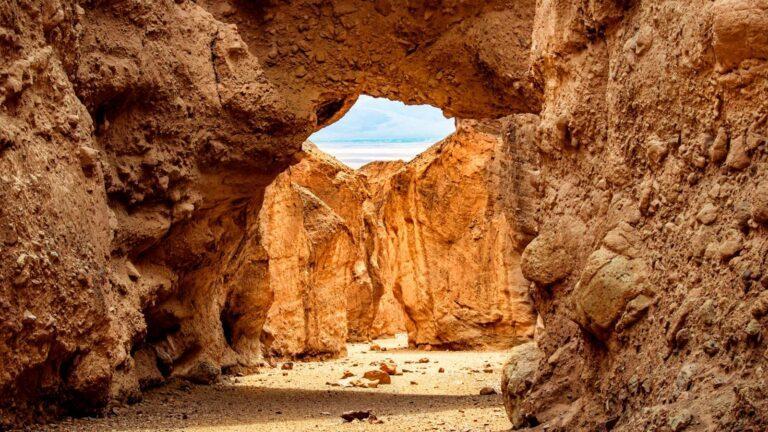
The Natural Bridge Trail in Yellowstone National Park leads hikers on a relatively short yet captivating journey to view a unique geological feature known as the Natural Bridge. Situated near the northern entrance of the park, this trail offers a convenient and accessible way to witness the park’s diverse landscapes and the fascinating effects of erosion on the rocks.
Beginning at the trailhead, visitors wind through a picturesque forested area, providing a peaceful setting for the hike. The trail’s moderate difficulty level makes it suitable for a range of hikers, from families to those seeking a leisurely stroll through Yellowstone’s natural wonders.
As hikers progress, the trail opens up to reveal the Natural Bridge, an impressive rock formation sculpted by the erosive forces of Bridge Creek over thousands of years. The bridge spans approximately 51 feet (15.5 meters) and arches gracefully over the creek below. It’s a captivating example of the ongoing geological processes that shape the landscape of Yellowstone.
During the warmer months, the surrounding area is adorned with wildflowers, adding a burst of color to the scene. The contrast of the delicate flora against the rugged rocks enhances the visual appeal of the Natural Bridge Trail.
For those interested in the geological history of the area, the trail provides interpretive signs offering insights into the forces that contributed to the formation of the Natural Bridge. The park’s commitment to education and preservation ensures that visitors can appreciate the natural wonders while understanding the geological significance of the features they encounter.
The Natural Bridge Trail is a relatively short loop, making it an ideal stop for those with limited time or as part of a broader exploration of Yellowstone’s northern region. Its accessibility and the unique beauty of the Natural Bridge make it a worthwhile destination for nature enthusiasts, photographers, and anyone seeking a glimpse into the geological marvels that define Yellowstone National Park.
As hikers approach the Natural Bridge, the sounds of flowing water and the crisp mountain air create a serene atmosphere. The vantage points along the trail provide different perspectives of the bridge, allowing visitors to appreciate its size and intricacies. The arching formation, carved by the forces of erosion, stands as a testament to the ever-changing nature of Yellowstone’s geology.
The Natural Bridge itself serves as a backdrop for memorable photographs, especially during the golden hours of sunrise or sunset when the warm hues of the sunlight cast enchanting reflections on the rocks. The viewing areas near the bridge allow visitors to take in the details of the geological layers and textures that contribute to its unique character.
For those interested in birdwatching, the surrounding forested areas may offer opportunities to spot various bird species. The tranquil setting and the babbling sounds of Bridge Creek create a haven for both wildlife and visitors alike.
Beyond the Natural Bridge, the trail continues through the park’s diverse landscapes. Exploring the surrounding area may reveal additional geological features and a chance to witness the resilience of nature in the face of constant change.
Whether enjoyed as a brief stop or as part of a broader exploration of Yellowstone’s northern wonders, the Natural Bridge Trail offers a delightful blend of natural beauty, geological fascination, and the soothing ambiance of the wilderness. It stands as a reminder of the dynamic processes that have shaped Yellowstone National Park over millennia, inviting visitors to connect with the park’s rich geological history in a relatively compact and accessible setting.
12. Wraith Falls
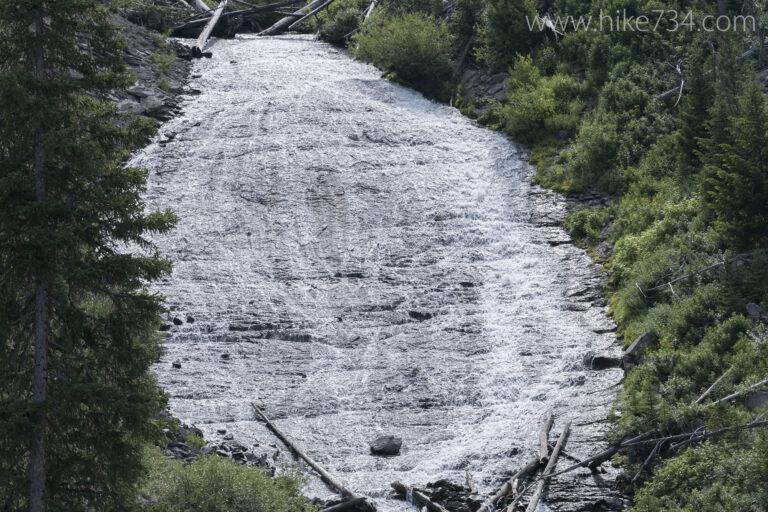
Nestled within the picturesque landscape of Yellowstone National Park, Wraith Falls stands as a captivating natural attraction accessible via a short and family-friendly trail. Located near the north entrance of the park, this waterfall offers visitors a serene and scenic experience amidst the park’s diverse ecosystems.
The trailhead to Wraith Falls is easily accessible from the main road, providing a convenient option for those looking to explore the beauty of Yellowstone without embarking on an extended hike. The short trail weaves through a peaceful forested area, offering glimpses of the surrounding mountains and meadows.
As hikers progress along the well-maintained trail, the sounds of a cascading stream become more prominent, heightening the anticipation of the approaching waterfall. The trail opens up to reveal Wraith Falls, a graceful cascade with water flowing gently over rocky ledges. The falls, surrounded by lush vegetation and framed by the park’s signature pine trees, create a tranquil and picturesque scene.
Wraith Falls is named after the mist or “wraiths” created by the fine spray of water as it descends, adding an ethereal quality to the waterfall. During the warmer months, wildflowers bloom along the trail and around the falls, enhancing the visual appeal of the surroundings.
The relatively low elevation gain and short distance make Wraith Falls Trail suitable for visitors of all ages and fitness levels. Interpretive signs along the trail provide information about the park’s flora, fauna, and the geological processes that contribute to the formation of waterfalls like Wraith Falls.
Whether you’re a casual visitor seeking a brief and scenic stroll or a dedicated nature enthusiast looking to appreciate the smaller wonders of Yellowstone, Wraith Falls offers a charming and easily accessible opportunity to connect with the park’s natural beauty. The soothing sounds of falling water and the peaceful ambiance of the falls create a memorable experience, making Wraith Falls a hidden gem within the vast tapestry of Yellowstone National Park.
As you linger near Wraith Falls, the refreshing mist from the cascading water provides a welcome respite, especially on warmer days. The viewing area allows visitors to appreciate the falls from different angles, capturing the play of sunlight on the water and the surrounding landscape. It’s a serene spot for contemplation and photography, inviting you to savor the tranquility of nature.
The surrounding area of Wraith Falls is rich in biodiversity, and keen-eyed observers may spot various bird species flitting among the trees and wildflowers. The falls and its immediate surroundings create a microcosm of Yellowstone’s ecosystems, offering a glimpse into the interconnected web of life that thrives in the park.
Wraith Falls is also conveniently located near other points of interest, making it an ideal addition to a broader exploration of Yellowstone’s northern region. Whether you’re on a road trip through the park or seeking a short nature break, the falls present an opportunity to stretch your legs and absorb the beauty of Yellowstone without committing to a lengthy hike.
Visiting Wraith Falls during different seasons provides varied experiences. In the spring and early summer, the landscape bursts into color with wildflowers, while the falls maintain a robust flow. As autumn arrives, the surrounding foliage transforms into a palette of reds and golds, adding a different kind of vibrancy to the scene.
The simplicity and accessibility of Wraith Falls make it a versatile stop for a wide range of visitors, from families with children to those looking for a peaceful interlude in nature. It’s a reminder that within Yellowstone’s vast expanse, there are hidden gems waiting to be discovered, each contributing to the park’s reputation as a sanctuary of natural wonders.
13. Firehole Canyon Drive
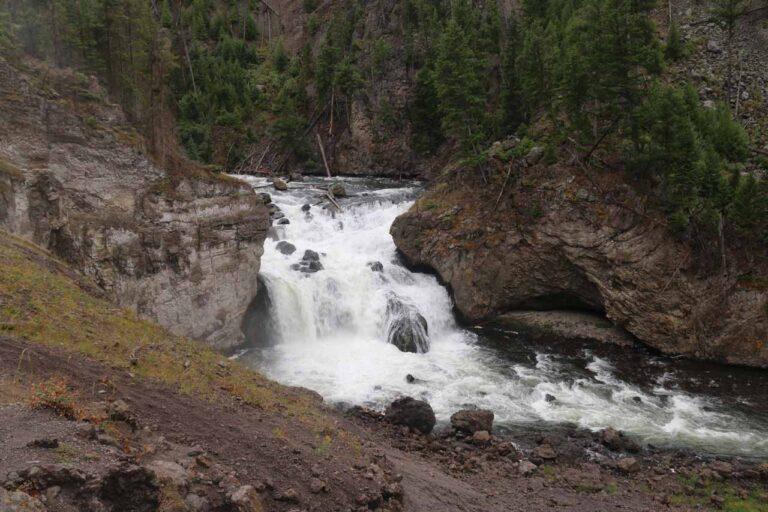
Firehole Canyon Drive offers a scenic and winding route through the southwestern corner of Yellowstone National Park, providing visitors with breathtaking views of the Firehole River and its picturesque canyon. This one-way drive is a delightful detour for those seeking a serene and immersive experience within the park’s diverse landscapes.
Beginning at the Madison Junction, Firehole Canyon Drive takes travelers alongside the meandering Firehole River. The road meanders through a landscape marked by towering cliffs, vibrant meadows, and the soothing sounds of the flowing river. The drive is particularly stunning during the fall when the surrounding foliage transforms into a mosaic of autumnal colors.
One of the highlights of Firehole Canyon Drive is the opportunity to witness the Firehole Falls. This stunning waterfall cascades over a volcanic rock ledge, creating a mesmerizing display of water and mist. A designated overlook provides a vantage point for visitors to capture the beauty of the falls and appreciate the geological features that shape the Firehole River.
The canyon itself is a testament to the dynamic forces that have shaped Yellowstone’s landscape. The Firehole River, known for its thermal contributions from nearby geothermal features, flows through the canyon, creating a unique juxtaposition of cool river waters against the warmth of thermal springs.
During the summer months, the drive becomes a scenic route for wildlife viewing. Bison, elk, and other animals are often spotted along the riverbanks or grazing in the adjacent meadows. The combination of geological wonders, serene river views, and potential wildlife sightings makes Firehole Canyon Drive a well-rounded experience for nature enthusiasts and photographers alike.
While Firehole Canyon Drive is typically open from late spring to early fall, road conditions may vary, and it’s advisable to check for current information before planning your visit. Whether enjoyed as a leisurely drive or as part of a broader exploration of Yellowstone’s attractions, Firehole Canyon Drive offers a captivating journey through the park’s diverse and captivating landscapes.
As you continue along Firehole Canyon Drive, the journey unfolds with scenic pullouts and overlooks that invite travelers to pause and absorb the natural beauty. The river’s course carves through the canyon, and the geothermal features contribute to the unique character of the landscape. Steam may rise in the distance, adding an ethereal quality to the surroundings.
The drive offers not only visual delights but also the opportunity to experience the sensory aspects of Yellowstone. The sound of rushing water, the earthy scent of the forest, and the occasional whisper of the wind through the canyon create a multisensory journey.
For those seeking a more immersive experience, Firehole Canyon Drive connects to other notable attractions within Yellowstone. The road system provides access to the iconic Old Faithful area, the Fountain Paint Pots, and the Grand Prismatic Spring, making it a convenient route for those looking to explore the park’s diverse geothermal features.
Firehole Canyon Drive is particularly enchanting during the golden hours of sunrise and sunset. The soft light enhances the warm hues of the canyon walls and highlights the reflections on the river’s surface. It’s a magical time to capture the beauty of the landscape with the play of light and shadow.
The drive also caters to anglers, as the Firehole River is renowned for its excellent fly-fishing opportunities. The combination of thermal features and diverse aquatic life in the river makes it an attractive destination for those seeking a quiet day by the water.
As you conclude your journey along Firehole Canyon Drive, the memories of the winding road, the impressive Firehole Falls, and the overall tranquility of the canyon will linger. It’s a testament to the park’s ability to offer diverse and captivating experiences, each turn revealing a new facet of Yellowstone’s natural wonders.
14. Elephant Back Mountain Trail
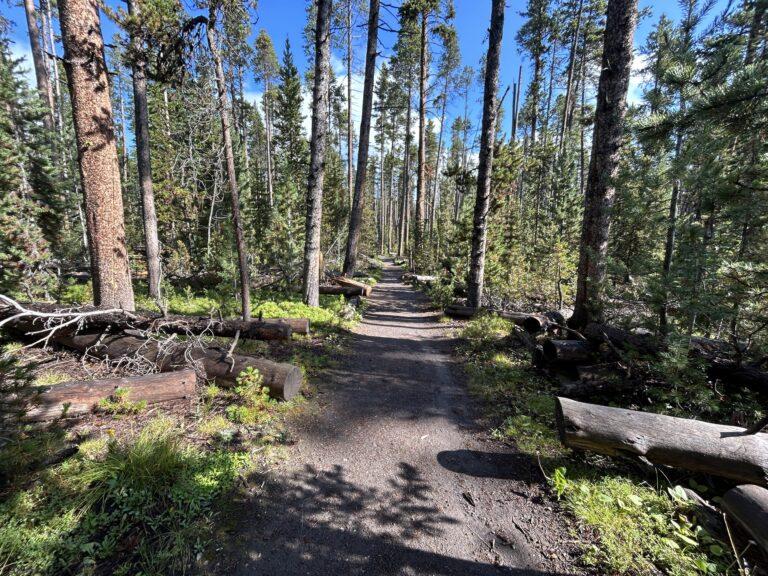
The Elephant Back Mountain Trail in Yellowstone National Park offers hikers a rewarding adventure through varied terrain, showcasing stunning vistas, serene lakes, and a panoramic view from the summit. This moderate to strenuous trail provides an opportunity to experience the natural beauty of Yellowstone’s backcountry.
Beginning near the northern end of Yellowstone Lake, the trail ascends Elephant Back Mountain, offering hikers a gradual climb through a mixed forest of lodgepole pines and meadows. As you ascend, the trail opens up to reveal scenic views of the surrounding landscape, including glimpses of Yellowstone Lake below.
One of the highlights of the trail is the chance to explore natural wonders such as the Ribbon Lake. Nestled amidst the mountainous terrain, Ribbon Lake is known for its unique shape, resembling a ribbon draped across the landscape. The clear waters of the lake, surrounded by lush vegetation, provide a picturesque setting for hikers to enjoy.
Continuing along the trail, the ascent becomes steeper as hikers approach the summit of Elephant Back Mountain. The effort is rewarded with a breathtaking panoramic view that includes Yellowstone Lake, the Absaroka Range, and the Hayden Valley. The summit provides an excellent vantage point for taking in the expansive beauty of the park.
The Elephant Back Mountain Trail is also notable for its wildlife sightings. Hikers may encounter various bird species, including eagles and ospreys, as well as glimpses of larger mammals such as elk and bison. The diversity of the park’s ecosystems is on full display throughout the hike.
The trail offers a versatile experience, making it suitable for both day hikers and those seeking a more extended backcountry adventure. The journey through Elephant Back Mountain provides a sense of solitude and a connection with the untamed wilderness that defines Yellowstone National Park.
Whether you’re drawn to the panoramic views, the geological wonders, or the chance to encounter Yellowstone’s diverse wildlife, the Elephant Back Mountain Trail stands as a captivating exploration of the park’s natural treasures.
As hikers progress towards the summit of Elephant Back Mountain, the landscape evolves, revealing alpine meadows dotted with wildflowers during the warmer months. The scent of pine fills the air, and the trail becomes more rugged, adding an adventurous element to the hike.
Reaching the summit is a culmination of the trail’s challenges, and the reward is a 360-degree spectacle of Yellowstone’s wilderness. From this elevated vantage point, hikers can appreciate the vastness of Yellowstone Lake and the intricate network of rivers and forests that extend across the landscape. The Absaroka Range, with its rugged peaks, provides a dramatic backdrop to the serene beauty of the lake.
The summit also serves as an ideal spot for a well-deserved break or a picnic, allowing hikers to soak in the tranquility of the surroundings. The sounds of nature, the gentle rustling of the wind, and the distant calls of wildlife contribute to the sense of solitude atop Elephant Back Mountain.
For those with a keen interest in geology, the trail provides opportunities to observe unique rock formations and gain insights into the park’s volcanic past. Interpretive signs along the trail offer educational information, enriching the hiking experience with a deeper understanding of the natural forces that have shaped Yellowstone’s terrain.
The Elephant Back Mountain Trail caters to various skill levels, offering shorter options for those seeking a less strenuous hike. The diversity of ecosystems encountered along the trail, from dense forests to open meadows, showcases the ecological richness of Yellowstone.
As the descent begins, hikers may catch glimpses of Yellowstone Lake through the trees, a reminder of the interconnectedness of the park’s features. The return journey allows for reflection on the beauty witnessed and the sense of accomplishment gained from conquering Elephant Back Mountain.
Whether you embark on this trail for the panoramic views, the exploration of Ribbon Lake, or the physical challenge, the Elephant Back Mountain Trail remains a memorable and enriching experience, providing a deeper connection to the natural wonders that define Yellowstone National Park.
15. Storm Point Trail

The Storm Point Trail in Yellowstone National Park offers a delightful and accessible hiking experience along the shores of Yellowstone Lake. This relatively easy trail is known for its scenic beauty, diverse wildlife, and captivating views of the largest high-altitude lake in North America.
Beginning near the Indian Pond parking area, the Storm Point Trail takes hikers through a landscape of lodgepole pine forests and meadows. The trail is well-marked, making it suitable for visitors of varying hiking abilities, including families and those seeking a leisurely stroll to enjoy the park’s natural wonders.
As the trail progresses, it leads to the namesake of the area, Storm Point, a prominent peninsula extending into Yellowstone Lake. Along the way, hikers may encounter wildflowers, especially during the summer months, adding bursts of color to the surroundings.
Storm Point offers expansive views of Yellowstone Lake and the Absaroka Range, creating a picturesque backdrop for those looking to immerse themselves in the tranquility of the park. The lakeshore provides a peaceful setting, inviting visitors to pause, enjoy the scenery, and perhaps spot waterfowl or bald eagles along the water’s edge.
The trail is also known for its wildlife sightings, with opportunities to observe bison, elk, and other animals that frequent the area. The diverse habitats along the trail contribute to the richness of wildlife, making it an excellent location for birdwatching and nature photography.
Given its accessibility and shorter length, the Storm Point Trail is an excellent choice for those with limited time or those seeking a more relaxed outdoor experience. The combination of lakeside views, diverse ecosystems, and the chance to encounter Yellowstone’s wildlife makes this trail a well-rounded introduction to the park’s natural wonders.
Whether you’re looking for a family-friendly hike, a peaceful lakeside stroll, or a chance to observe Yellowstone’s diverse flora and fauna, the Storm Point Trail provides a rewarding and enjoyable experience amid the breathtaking landscapes of Yellowstone National Park.
As hikers approach Storm Point, the trail offers an opportunity to explore the rocky shoreline and witness the dynamic interactions between land and water. The geological features of the area become apparent, with wave-cut rocks and the soothing sounds of Yellowstone Lake creating a serene atmosphere.
Storm Point itself provides a unique perspective on the vastness of Yellowstone Lake and the surrounding mountains. The ever-changing weather conditions add an extra layer of drama to the landscape, making Storm Point a fitting name for this prominent location. Whether bathed in sunlight, shrouded in mist, or facing the brunt of a passing storm, the point offers a captivating setting for nature enthusiasts and photographers alike.
The proximity to Yellowstone Lake also allows hikers to experience the park’s aquatic ecosystems up close. The clear waters of the lake showcase the underwater features, and the occasional sighting of fish or waterfowl adds to the diversity of the trail experience.
Throughout the hike, interpretive signs along the trail provide information about the geology, flora, and fauna of the area, enhancing the educational aspect of the journey. It’s an opportunity for visitors to deepen their understanding of the natural processes at play in Yellowstone and the delicate balance that sustains its ecosystems.
As the trail winds its way back, the return journey provides a different perspective of the landscape. The combination of forested sections, meadows, and lakeside views creates a varied and engaging hike that showcases the ecological richness of the Yellowstone Lake area.
The Storm Point Trail, with its accessibility and diverse offerings, stands as a testament to the beauty and diversity that define Yellowstone National Park. Whether enjoyed as a standalone experience or as part of a broader exploration of the park’s wonders, this trail provides a memorable connection to the untamed landscapes and vibrant ecosystems that make Yellowstone a cherished natural gem.

